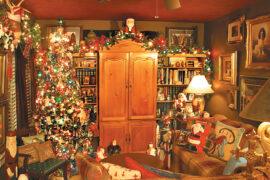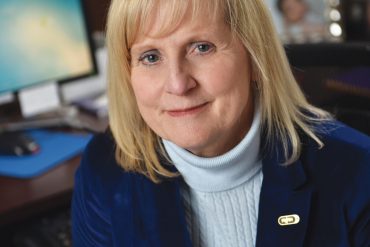By Kimberly Carico Simpson
HQ 50 | WINTER 2004
Orange, red and gold leaves of fall, the crisp smell of cold air and the harried holiday season are just some things people look forward to when the days get shorter. For some people, however, shorter days also mean winter blues.
The symptoms are familiar – sleeping more than usual, craving certain types of food, lower-than-normal energy levels, a low mood and much to the dismay of many, weight gain. For millions of Americans, these dreaded “winter blahs”have a name – Seasonal Affective Disorder, often called SAD.
“Everybody talks about the winter blues,”said Helene Jacobs, M.D., child, adolescent and adult psychiatrist in private practice in Huntington. “Most people will say, ‘I get more down,’ or ‘I have less energy in the winter.’ People with Seasonal Affective Disorder often crave carbohydrates and are less interested in things in general. They also sleep more than usual. Most people have one or two of those things – to some degree – in the winter.”
But at what point do you call it a disorder? Most commonly, Seasonal Affective Disorder is a mood disorder where people get depressed in the fall and winter, and the depression lifts in the spring and summer. According to the National Organization for Seasonal Affective Disorder (NOSAD), which can be found on the internet at www.nosad.org, additional symptoms of SAD include fatigue, loss of self-esteem, feelings of hopelessness, the desire to avoid social contact and a decreased interest in sex. In extreme cases, SAD sufferers have suicidal thoughts. While many people will agree it’s easier to give into winter’s temptation of a cozy catnap, some people will recognize the multiplicity and severity of these symptoms as scenes from their own lives in winters past. While SAD is tolerable for some sufferers, it can be debilitating for others.
“To meet the criteria for SAD, the person must experience a full affective episode and have the disorder for two years in a row, both occurring at the same time of year,”Dr. Jacobs said.
Most commonly, SAD strikes in December, January and February. SAD also is more common in women and usually first manifests itself between ages 18 to 30.
“Everybody wants things to be simple and neat,”Dr. Jacobs said. “But defining Seasonal Affective Disorder is more complicated than that. It’s easy to say you’re depressed in the winter and fine in the summer, but that is just one variant of SAD. Seasonal Affective Disorder is a major mood disregulation with a seasonal course. The public often thinks SAD is less important than depression. In essence, it’s the same.”
There is a geographic factor to SAD and its effect on people. Dr. Jacobs explained that where a person lives could determine whether or not SAD ever manifests itself in the individual.
“Everyone inherits some range of vulnerability to problems regulating their mood. The geographical component comes in if your vulnerability is somewhere in the middle of the road and you are affected by the amount of daylight you receive. If you live in Florida, the depression might never express itself, but if you live in the north or northeast, then it probably would.”
What causes SAD? Shorter daylight hours and lack of sunlight leads to a biochemical imbalance in the hypothalamus in the brain, according to NOSAD. What does this mean? SAD is treatable.
According to the National Alliance for the Mentally Ill (www.NAMI.org), a 1986 study showed that 80 percent of 112 patients improved significantly with light therapy, also referred to as phototherapy.
In phototherapy, bright full spectrum light is used to reverse the symptoms of SAD. The light is believed to alter chemicals in the brain that help regulate mood. In some cases, certain antidepressant drugs are helpful.
“Light therapy is good, and many patients respond to it,”Dr. Jacobs said. “As SAD gets more severe, the patient may need an anti-depression medication.”
Some patients may require significant doses of light therapy, Dr. Jacobs explained. For those people who don’t have time to take in the needed doses of light (most often one hour early in the morning and one hour late in the afternoon), medication might come into play. A psychiatrist can prescribe the proper amount of phototherapy and needed medication, if any, based on the degree to which the patient suffers from SAD.
NOSAD reports that ordinary light bulbs are not strong enough for treating SAD. Instead, an extremely bright light is required. There are special “light boxes”that produce the required light intensity – 10,000 LUX or the same amount of light one would get from looking out the window on a spring day. Simply type “light box”into your favorite internet search engine and you will find hundreds of links to online retailers. Light treatment, however, isn’t new.
“They used light to treat depression in the early 1920s,”Dr. Jacobs said. She also explained that even earlier, in 1845, a European doctor gave his patient this prescription to cure seasonal depression: spend the winter in Italy rather than Belgium.
While anyone would love to fill that prescription, more realistic treatments are available.
“My first choice for treatment would be to see a psychiatrist for a complete evaluation,”Dr. Jacobs said. “If a person doesn’t have access to a psychiatrist, then they can work with their family practice doctor.”
Seeing a psychiatrist sounds scary for some people, and for others causes embarrassment. But today, there is less stigma than in years past surrounding mental disorders.
“I think there’s a greater awareness and understanding of some mental disorders,”Dr. Jacobs said. “If you had to rate disorders and the stigma associated with them, Seasonal Affective Disorder probably has the lowest amount of stigma. I suspect it’s because most people are affected to some degree by the exposure of daylight, so the idea of someone’s mood dipping in the winter resonates with them.”
At the same time, Dr. Jacobs stresses that despite being a more commonly and openly discussed form of depression, SAD still is a very real, very significant form of depression.
“I don’t really agree with the phrase, ‘It’s only SAD.’ It’s a form of major depression, which is an incredibly painful, brutal illness. Depression is so potent that it affects your productivity at work, the quality of friendships, relationships and your marriage. It affects your spouse, your children and other people in your life. People often underestimate the potency of depression, regardless of the flavor of it.
“On the other hand, I do agree with the phrase, ‘It’s only SAD,’ in that SAD and the vast majority of depressions are very treatable, and in a relatively short amount of time life really can go back from shades of gray to technicolor.”
The Warning Signs
• Wanting to be alone
• Avoiding activities you usually enjoy
• A lingering melancholy
• A change in appetite – either eating more or less (especially carbohydrates)
• Sleeping more than usual
• Low energy
• Difficulty concentrating
• Indecisiveness




